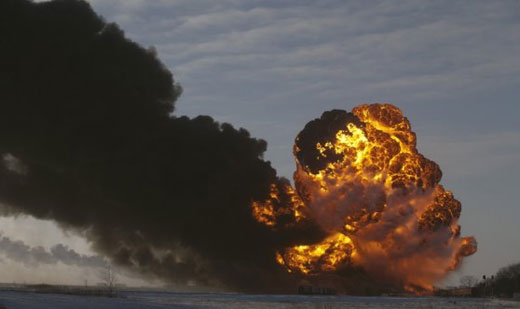
In what was a devastating end to 2013, on Dec. 30, just a mile outside Casselton, N.D., a train carrying oil collided with another train, producing a series of explosions that left 10 cars ablaze. The disaster sent fireballs hurtling into the sky, black smoke that could be seen for 15 miles, and prompted the evacuation of nearby residents. Those evacuees have since been cleared to re-enter their homes, but the aftermath of the event has rung in the new year with a harsh lesson about the consequences of oil transportation.
North Dakota is home to a massive oil boom, and it is therefore that much more sobering that such havoc occurred there, of all places. Simultaneously, there has been an uptick in oil shipment via rail, which has been touted by corporations as a “safer alternative.” Their stance on this matter has, absurdly enough, remained the same even after the recent string of train derailments and explosions throughout North America, including in the Quebec town of Lac-Megantec, and in the Alberta town of Gainford. Meanwhile, pipelines are, of course, no safer, as the bursting of a Koch Brothers-owned pipeline in Texas proved in November.
It is also troubling to know that in Canada, where much rail-bound oil goes, the agency responsible for safeguarding train transport is operating with a reduced budget. During 2013, the country’s transportation regulator, Transport Canada, had its funding cut by almost 30 percent, down to $1.5 billion.
According to officials, in the case of the explosion near Casselton, that town’s residents apparently dodged a much worse disaster. “We could have had this go in so many different ways,” said Sheriff Paul Laney of Cass County, which includes Casselton. “If that thing happened a half mile into town, we’d be having a very, very different discussion here today.” That doesn’t leave much to the imagination; one could simply look to the Lac-Megantec disaster, which left 47 dead, to see what the horrific alternative could have been.
Grist writer John Upton, meanwhile, noted that people ought to reject comparisons between train and pipeline oil delivery, noting that the fossil fuel is innately dangerous, no matter how it is transported. “The comparison obfuscates an obvious reality,” he said, which is that “the oil can’t be moved safely at all. After a string of pipeline and rail accidents in recent years, it’s clear that letting the energy industry move incendiary bulk fluids around the continent is like tossing a book of matches into the crib to keep little Johnny happy while his folks stare at the television. And that’s without even considering the climate impacts of the fossil fuel-mining binge.”
As for the cause of the crash near Casselton, it is still being investigated. Though the oil train was equipped with a black box and forward-facing video cameras, officials with the National Transportation Safety Board are not so sure those will be in good enough condition to analyze.
Wayde Schafer, a spokesman for the Sierra Club, had previously predicted more of these disasters would occur as corporate support for oil-by-train transporation increased. “As if we needed another wake-up call after Quebec,” he said, “here’s another wake-up call.”
Photo: A fireball goes up at the site of the oil train crash near Casselton, N.D. Bruce Crummy/AP












Comments